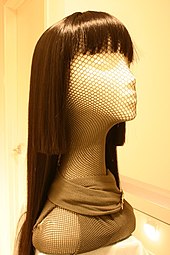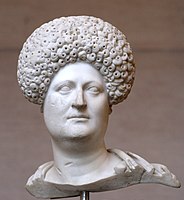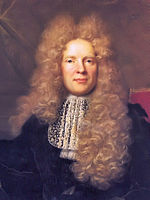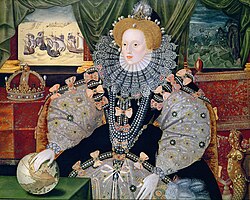Wig
This article needs additional citations for verification. (July 2009) |

A wig is a head covering made from human hair, animal hair, or synthetic fiber that is worn for fashion or other reasons, including cultural tradition and religious observance. The word wig is short for periwig and first appeared in the English language around 1675.
Some people wear wigs to disguise baldness; a wig may be used as a less intrusive and less expensive alternative to medical therapies for restoring hair. Wigs may also be used as an article of apparel, or to fulfill a religious obligation. Actors often wear costume wigs in order to portray characters.
History
Ancient use
The ancient Egyptians wore wigs to shield their shaved, hairless heads from the sun. They also wore the wigs on top of their hair using beeswax and resin to keep the wigs in place. Other ancient cultures, including the Assyrians,[1] Phoenicians, Greeks and Romans, also used wigs as an everyday fashion.
-
Egyptian couple wearing formal wigs of the 4th of 5th dynasties.
-
Bust of a Roman woman wearing a "diadem" wig, circa 80 CE.
In Korea, gache were popular among women until it was banned in the late 18th century, while wigs were rarely used in China and Japan except in the traditional theatre.
16th and 17th centuries
After the fall of the Roman Empire, the use of wigs fell into disuse in the West for a thousand years until they were revived in the 16th century as a means of compensating for hair loss or improving one's personal appearance. They also served a practical purpose: the unhygienic conditions of the time meant that hair attracted head lice, a problem that could be much reduced if natural hair were shaved and replaced with a more easily de-loused artificial hairpiece.[citation needed] Fur hoods were also used in a similar preventative fashion.
Royal patronage was crucial to the revival of the wig.[citation needed] Queen Elizabeth I of England famously wore a red wig, tightly and elaborately curled in a "Roman" style, while among men King Louis XIII of France (1601–1643) started to pioneer wig-wearing in 1624 when he had prematurely begun to bald.[2] This fashion was largely promoted by his son and successor Louis XIV of France (1638–1715) that contributed to its spread in European and European-influenced countries.
Perukes or periwigs for men were introduced into the English-speaking world with other French styles when Charles II was restored to the throne in 1660, following a lengthy exile in France. These wigs were shoulder-length or longer, imitating the long hair that had become fashionable among men since the 1620s. Their use soon became popular in the English court. The London diarist Samuel Pepys recorded the day in 1665 that a barber had shaved his head and that he tried on his new periwig for the first time, but in a year of plague he was uneasy about wearing it:
"3rd September 1665: Up, and put on my coloured silk suit, very fine, and my new periwig, bought a good while since, but darst not wear it because the plague was in Westminster when I bought it. And it is a wonder what will be the fashion after the plague is done as to periwigs, for nobody will dare to buy any haire for fear of the infection? That it had been cut off the heads of people dead of the plague."
Wigs were not without other drawbacks, as Pepys noted on March 27, 1663:
"I did go to the Swan; and there sent for Jervas my old periwig-maker and he did bring me a periwig; but it was full of nits, so as I was troubled to see it (it being his old fault) and did send him to make it clean."
With wigs virtually obligatory garb for men with social rank, wigmakers gained considerable prestige. A wigmakers' guild was established in France in 1665, a development soon copied elsewhere in Europe. Their job was a skilled one as 17th century wigs were extraordinarily elaborate, covering the back and shoulders and flowing down the chest; not surprisingly, they were also extremely heavy and often uncomfortable to wear. Such wigs were expensive to produce. The best examples were made from natural human hair. The hair of horses and goats was often used as a cheaper alternative.
-
Queen Elizabeth I, pictured in 1588.
-
Wigs 17th century
18th century

In the 18th century, men's wigs were powdered in order to give them their distinctive white or off-white color. Women in the 18th century did not wear wigs, but wore a coiffure supplemented by artificial hair or hair from other sources. Women mainly powdered their hair grey, or blue-ish grey, and from the 1770s onwards never bright white like men. Wig powder was made from finely ground starch that was scented with orange flower, lavender, or orris root. Wig powder was occasionally colored violet, blue, pink or yellow, but was most often used as off-white.
Powdered wigs (men) and powdered natural hair with supplemental hairpieces (women) became essential for full dress occasions and continued in use until almost the end of the 18th century. The elaborate form of wigs worn at the coronation of George III in 1761 was lampooned by William Hogarth in his engraving Five Orders of Periwigs. Powdering wigs and extensions were messy and inconvenient, and the development of the naturally white or off-white powderless wig (made of horsehair) for men made the retention of wigs in everyday court dress a practical possibility. By the 1780s, young men were setting a fashion trend by lightly powdering their natural hair, as women had already done from the 1770s onwards. After 1790, both wigs and powder were reserved for older, more conservative men, and were in use by ladies being presented at court. After 1790 English women seldom powdered their hair.
In 1795, the British government levied a tax on hair powder of one guinea per year. This tax effectively caused the demise of both the fashion for wigs and powder. Granville Leveson-Gower, in Paris during the winter of 1796, noted "The word citoyen seemed but very little in use, and hair powder being very common, the appearance of the people was less democratic than in England."[3]
Among women in the French court of Versailles in the mid-to-late 18th century, large, elaborate and often themed wigs (such as the stereotypical "boat poufs") were in vogue for women. These combed-up hair extensions were often very heavy, weighted down with pomades, powders, and other ornamentation. In the late 18th century these coiffures (along with many other indulgences in court life) became symbolic of the decadence of the French nobility, and for that reason quickly became out of fashion from the beginning of the French Revolution in 1789.
During the 18th century, men's wigs became smaller and more formal with several professions adopting them as part of their official costumes. This tradition survives in a few legal systems. They are routinely worn in various countries of the Commonwealth. Until 1823, bishops of the Church of England and Church of Ireland wore ceremonial wigs. The wigs worn by barristers are in the style favoured in the late eighteenth century. Judges' wigs, in everyday use as court dress, are short like barristers' wigs (although in a slightly different style), but for ceremonial occasions judges and also senior barristers (QCs) wear full-bottomed wigs.[4]
-
Marie Antoinette wearing the distinctive pouf style coiffure: her own natural hair is extended on the top with an artificial hairpiece.
-
Charles-Alexandre de Calonne by Élisabeth-Louise Vigée-Le Brun (1784), London, Royal Collection. The Vicomte de Calonne is shown wearing a powdered wig; the powder that has fallen from the wig is visible on his shoulders.
-
Grand Duke Constantine Pavlovich of Russia as a boy (c. 1795). The latest-born notable person to be portrayed wearing a powdered wig tied in a queue.
19th and 20th centuries
The wearing of wigs as a symbol of social status was largely abandoned in the newly created United States and France by the start of the 19th century. In the United States, only the first five Presidents, from George Washington to James Monroe, wore powdered wigs according to the old-fashioned style of the 18th century.[5]
The latest-born notable person to be portrayed wearing a powdered wig tied in a queue according to this old fashion was Grand Duke Constantine Pavlovich of Russia (born in 1779, portrayed in 1795).[6][7]
Women's wigs developed in a somewhat different way. They were worn from the 18th century onwards, although at first only surreptitiously. Full wigs in the 19th and early 20th century were not fashionable. They were often worn by old ladies who had lost their hair.[citation needed] In the film Mr. Skeffington (1944), when Bette Davis has to wear a wig after a bout of diphtheria, it is a moment of pathos and a symbol of her frailty.[citation needed]
During the late nineteenth and early twentieth century hairdressers in England and France did a brisk business supplying postiches, or pre-made small wiglets, curls, and false buns to be incorporated into the hairstyle. The use of postiches did not diminish even as women's hair grew shorter in the decade between 1910 and 1920, but they seem to have gone out of fashion during the 1920s.[8] In the 1960s a new type of synthetic wig was developed using a modacrylic fiber which made wigs more affordable. Reid-Meredith was a pioneer in the sales of these types of wigs. [9]
Military wigs
From the late 17th to early 19th centuries, European armies wore uniforms more or less imitating the civilian fashions of the time, but with militarized additions. As part of that uniform, officers wore wigs more suited to the drawing rooms of Europe than its battlefields. The late 17th century saw officers wearing full-bottomed natural-coloured wigs, but the civilian change to shorter, powdered styles with pigtails in the early 18th century saw officers adopting similar styles. The elaborate, over-sized court-styles of the late 18th century were not followed by armies in the field however, as they were impractical to withstand the rigours of military life and simpler wigs were worn.
Whilst officers normally wore their own hair short under a powdered wig, the rank and file of the infantry was not afforded such luxury. Instead of wigs, the men grew their hair long and according to the prevailing fashion in a nation’s army, hair was either allowed to grow long with simple modeling, as in the French army of the 1740s, or else was elaborately coiffured as in Prussian and British armies. In the case of British soldiers of the 1740s, contemporary artwork suggests that they cut their hair short, which was not the case. Instead, the men used tallow or other fat to grease the hair, which was then fashioned into pigtails and tied back into the scalp hair to give the impression of short hair. It was then liberally dusted with powdered chalk to give the impression of a powdered wig. Later in the century, hair was likewise tied back, greased and powdered, but false hair pigtails were adopted, kept in a tubular queue and tied back with ribbons to the soldier’s own hair. The overall effect was that of a wig with a long tail and bow. The Prussian army took personal hairstyles to an extreme during the time of Frederick The Great, each soldier commonly having a long pigtail hanging down the back nearly to waist level.
By contrast, in the 1780s Russian General Potemkin abhorred the tight uniforms and uncomfortable wigs and powdered coiffures worn by his soldiers and instigated a complete revision of both. As well as comfortable, practical, well-fitting uniforms, his reforms introduced neat, natural hairstyles for all, with no wigs, powder and grease or hair-tying evident.
Formal military hairstyles lasted until beyond the end of the 18th century and it was the French Revolution which spelled the end of wigs and powdered, greased hairstyles in modern, Western armies. Powdered hair and pigtails made a brief return during Napoleon’s reign, being worn by infantry of his Foot Grenadiers and Foot Chasseurs of the Old Guard and the Horse Grenadiers of the Guard.
Merkin
A merkin is a pubic wig often worn as a decorative item or for theatrical and fashion purposes. They are sometimes viewed as erotic and some designs are meant for entertainment or as a form of comedy.
Current usage
In Britain, most Commonwealth nations, and the Republic of Ireland special wigs are also worn by barristers, judges, and certain parliamentary and municipal or civic officials as a symbol of the office. Hong Kong barristers and judges continue to wear wigs as part of court dress as an influence from their former jurisdiction of the Commonwealth of Nations. In July 2007, judges in New South Wales, Australia voted to discontinue the wearing of wigs in the NSW Court of Appeal.[10] New Zealand lawyers and judges have ceased to wear wigs except for special ceremonial occasions such as openings of Parliament or the calling of newly qualified barristers to the bar.
A number of celebrities, including Nicki Minaj, Dolly Parton, Lady Gaga, Diana Ross & The Supremes, Tina Turner and Raquel Welch have popularized wigs. Cher has worn all kinds of wigs in the last 40 years- from blonde to black, and curly to straight. They may also be worn for fun as part of fancy dress (costume wearing), when they can be of outlandish colour or made from tinsel. They are quite common at Halloween, when "rubber wigs" (solid bald cap-like hats, shaped like hair), are sold at some stores.
Jewish law requires married women to cover their hair for reasons of modesty (tznius). Some women wear wigs, known as sheitels, for this purpose. Haredi, Orthodox and Modern Orthodox Jewish women will often wear human-hair wigs.
Wigs are used in film, theater, and television. In the Japanese film and television genre Jidaigeki, wigs are used extensively to alter appearance to reflect the Edo Period when most stories take place. Only a few actors starring in big-budgeted films and television series will grow their hair so that it may be cut to the appropriate hair style, and forgo using a wig.
Wigs are worn by some people on a daily or occasional basis in everyday life. This is sometimes done for reasons of convenience, since wigs can be styled ahead of time. They are also worn by individuals who are experiencing hair loss due to medical reasons (most commonly cancer patients who are undergoing chemotherapy, or those who are suffering from alopecia areata).
Some men who crossdress as women wear wigs in different styles to make their hair seem more feminine.
Manufacture

There are two methods of attaching hair to wigs. The first and oldest is to weave the root ends of the hair onto a warp of three silk threads to form a sort of fringe called a "weft". The wefts are then sewn to a foundation made of net or other material. In modern times, the wefts can also be made with a specially adapted sewing machine, reducing the amount of hand labour involved. In the 19th century another method came into use. A small hook called a "ventilating needle", similar to the tambour hooks used for decorating fabric with chain-stitch embroidery at that period, is used to knot a few strands of hair at a time directly to a suitable foundation material. This newer method produces a lighter and more natural looking wig. High quality custom wigs, and those used for film and theatrical productions are usually done this way. It is also possible to combine the two techniques, using weft for the main part of the wig and ventilating hair at the edges and partings to give a fine finish.
Measurement
Making custom wigs starts with measuring the subject's head. The natural hair is arranged in flat curls against the head as the various measurements are taken. It is often helpful to make a pattern from layers of transparent adhesive tape applied over a piece of plastic wrap, on which the natural hairline can be traced accurately. These measurements are then transferred to the "block", a wooden or cork-stuffed canvas form the same size and shape as the client's head.[11][12]
Foundation
Depending on the style of the wig, a foundation is made of net or other material, different sizes and textures of mesh being used for different parts of the wig. The edges and other places might be trimmed and reinforced with a narrow ribbon called "galloon". Sometimes flesh colored silk or synthetic material is applied where it will show through the hair at crown and partings, and small bones or elastic are inserted to make the wig fit securely. Theatrical, and some fine custom wigs have a fine, flesh colored net called "hair lace" at the front which is very inconspicuous in wear and allows the hair to look as if it is coming directly from the skin underneath. These are usually referred to as "lace front wigs".[13]
Hair preparation
Natural hair, either human or from an animal such as a goat or yak, must be carefully sorted so that the direction of growth is maintained, root to root, and point to point. Because of the scale-like structure of the cortex of a hair shaft, if some hairs get turned the wrong way, they will ride backwards against their neighbors and cause tangles and matting. The highest quality of hair has never been bleached or colored, and has been carefully sorted to ensure the direction is correct. For less expensive wigs, this labour-intensive sorting process is substituted for by "processing" the hair. It is treated with a strongly base solution which partially dissolves the cortex leaving the strands smooth, It is then bleached and dyed to the required shade and given a synthetic resin finish which partially restores the strength and luster of the now damaged hair. Synthetic fiber, of course, is simply manufactured in the required colors, and has no direction.
The wigmaker will choose the type, length and colors of hair required by the design of the wig and blend them by pulling the hair through the upright teeth of a brush-like tool called a "hackle" which also removes tangles and any short or broken strands. The hair is placed on one of a pair of short-bristled brushes called "drawing brushes" with the root ends extending over one edge, and the second brush is pressed down on top of it so that a few strands can be withdrawn at a time, leaving the rest undisturbed.[13]
Adding the hair
Weft structured wigs can have the wefts sewn to the foundation by hand, while it is on the block or, as is common with mass-produced wigs, sewn to a ready-made base by skilled sewing machine operators. Ventilated (hand knotted) wigs have the hair knotted directly to the foundation, a few strands at a time while the foundation is fastened to the block. With the hair folded over the finger, the wigmaker pulls a loop of hair under the mesh, and then moves the hook forward to catch both sides of the loop. The ends are pulled through the loop and the knot is tightened for a "single knot", or a second loop is pulled though the first before finishing for a "double knot". Typically, the bulkier but more secure double knot is used over the majority of the wig and the less obvious single knot at the edges and parting areas. A skilled wigmaker will consider the number of strands of hair used and the direction of each knot to give the most natural effect possible.[14]
It takes generally six heads of hair to make a full human hair wig.[citation needed]
Styling
At this point, the hair on the wig is all the same length. The wig must be styled into the desired form in much the same manner as a regular stylist.[12]
Fitting
The subject's natural hair is again knotted tightly against the head and the wig is applied. Any remaining superfluous wiglace is trimmed away. Hairpins can be used to secure the lace to the hair and occasionally, skin-safe adhesives are used to adhere the wig against bald skin and to better hide any exposed lace. Finishing touches are done to the hair styling to achieve the desired effect.[12]
Types of human hair wigs
There are two basic kinds of human hair wigs: lace wigs and non-lace wigs (lace front or full lace.) Lace wigs are made partially (lace front) or entirely (full lace) of various forms of lace. Regular human hair wigs are similar to synthetic wigs in their design. Human hair wigs can also be "hand tied", where a full lace cap is used and each hair is attached one at a time.
Hair type is the distinguishing factor in human hair wigs. Four main types of hair are used in manufacturing : Chinese or "Malaysian", Indian, Indonesian or "Brazilian", and Caucasian or "European". The majority of human hair wigs are made of Chinese or Indian hair, while European hair is considered the most expensive and rare, as most donors are from Russia or Northern Europe, where there is a smaller portion of hair donors to the market.
Notable wig designers
- Willy Clarkson, who created wigs for London's West End theatre productions
- Nina Lawson, ran the Metropolitan Opera wig department from 1956 to 1987.
See also
Sister Projects
- Chisholm, Hugh, ed. (1911). . Encyclopædia Britannica (11th ed.). Cambridge University Press.
References
This article includes a list of general references, but it lacks sufficient corresponding inline citations. (July 2009) |
- ^ "Dumuzid and Jectin-ana". Etcsl.orinst.ox.ac.uk. December 19, 2006. Retrieved January 16, 2013.
- ^ by marcelgomessweden. "Louis XIII « The Beautiful Times". Thebeautifultimes.wordpress.com. Retrieved January 16, 2013.
- ^ Noted in Janet Gleeson, Privilege and Scandal: The Remarkable Life of Harriet Spencer, Sister of Georgiana 2006:178.
- ^ Judiciary.gov.uk
- ^ Real Life at the White House: 200 ... – Google Knihy. Books.google.cz. Retrieved April 20, 2010.
- ^ "Work: Portrait of Grand Duke Konstantin Pavlovich (1779-1831)". Scholarsresource.com. Retrieved January 16, 2013.
- ^ "IN offers Songs, Music, Videos, Games, Movie, Celebs, Download, E Mail, News, Devotion, Search Online "IN.com"". Connect.in.com. Retrieved January 16, 2013.
- ^ Emile Long, Hairstyles and Fashion: A Hairdresser's History of Paris, 1910–1920, edited with an introduction by Steven Zdatny, Berg (Oxford International Publishers Ltd), 1999 ISBN 1-85973-222-4
- ^ Associated Press. "Expert Says Korean Labor Market Knock Wig Market Askew". Retrieved October 8, 2013.
- ^ "Woolly headed? Not this verdict". The Sydney Morning Herald. August 2, 2007.
- ^ "The Art and Craft of Hairdressing", Wolters.
- ^ a b c "Wigs". How It's Made. Season 6. Episode 71. Discovery Channel Canada.
{{cite episode}}: Unknown parameter|serieslink=ignored (|series-link=suggested) (help); Unknown parameter|seriesno=ignored (|series-number=suggested) (help) - ^ a b "The Art and Craft of Hairdressing" Wolters
- ^ "The Art and Craft of Hairdressing" ed. N.E.B. Wolters, The New Era Publishing Company, Ltd. London, 1963
External links
- Royal Hairpieces (WikiTree), a brief account of royal wigs throughout history and around the globe.











